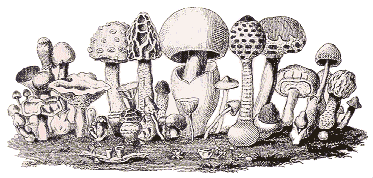In the last 30 years we have witnessed a rapid warming up of the climate in the British Isles. Global warming can influence the whole pattern of weather resulting in, for example later rainfall. The summer of 1976 was very dry up to October and most mycorrhizal fungi did not fruit that year. But what evidence have we got that fungi are an indicator of climate change?
Fungi are great opportunists; most have a very rapid dispersion mechanism based on the release of large numbers of airborne spores. As we start to see new species appearing from warmer parts of the world then one suspects that something is happening. Of course such species may have been established in the British Isles for some time but because of their rarity they have not been previously recorded. Rarity is very subjective and dependent on the availability of observers to spot and record new appearances.
One of the new arrivals is Amanita ovoidea a very common Mediterranean fungus with pine and holly oak that has spread through France and is now well established in the Isle of White. Flavoporus brownii a yellow resupinate polypore from Africa easily identified on dead wood was first found growing outdoors in 1995 (Devon). Previously it had only been found indoors in the British Isles. Other species which appear to have spread as a result of climate change are Perenniporia ochroleuca (an African polypore), Pulcherricium caeruleum (a brilliant blue Mediterranean species) and Stereum subtomentosum (orange and almost stipitate Mediterranean species).
Not all new arrivals are associated with climate change. Calocera pallidospathulata first reported in 1969 from Yorkshire has subsequently spread over much of the country and into mainland Europe. We donít know where it started out from but have much information about its subsequent spread. In this case climate change probably has not influenced its progress but we canít be absolutely sure. Some fungi will simply follow the introduction of new hosts. For example, Exobasidium japonicum from Japan known as the Azalea gall was first recorded in 1907 (Kent) and is now widespread. This species is very common wherever its hosts, the evergreen Asiatic azaleas imported from Japan, occur. The gall is first greenish yellow, changing to orange and red and the modified leaf becomes swollen to look like an apple.
The majority of new species are rusts or powdery mildews, some, but not all of which have spread through climate change. Powdery mildews often appear to come over as anamorphs until the weather gets warmer allowing for the sexual stage to proliferate. Microsphaera azaleae a powdery mildew found on Rhododendron and native to North America was first seen in 1969 (Scotland) as the asexual form but the teleomorph (sexual) stage was not recorded until 1998 (Shropshire) and this form is now widespread in the British Isles. It appears that the availability of high temperatures in summer is essential for the production of fruit bodies. Another powdery mildew from North America Microsphaera platani, which infects plane trees was first recorded in 1983 (London) as the asexual stage. In 1992 it was found in Kew and has now spread as far north as Warrington. However, in this case it is still spreading as the asexual form.
Norway maple has become a popular choice for new industrial estates (often the cultivated purple leaved form). Sawadaea tulasnei from central Europe causes mildew on Norway maple but prior to 1990 only the asexual stage had been recorded in the British Isles. In 1990 (Yorkshire and Kew) the teleomorph was first recorded and this form is now widespread and has reached as far north as Inverness. The evidence suggests that before 1990 conditions were not hot enough in summer for the fruiting stage to occur.
Probably the best example of a species that has been around as the asexual form until conditions change so that it can produce fruit bodies is the oak powdery mildew, Microsphaera alphitoides. Until recently this indigenous species was only found with fruit bodies in really hot summers. Now it is uncommon not to find fertile oak mildew. The newly arrived Horse Chestnut powdery mildew Erysiphe flexuosa (syn. Uncinula flexuosa) has always been found as the fertile form - the exception among American newcomers. First recorded in 2001 (Kew) it is now found in over 30 counties and has reached as far north as Cumbria. It is very conspicuous turning the tree grey and has even been recorded by Bruce while travelling through Switzerland by train! Possibly originally from Eastern Europe, it spread to North America and now has returned to Western Europe.
Further evidence for the influence of climate change has come from a study carried out by Bruce of Myxomycetes found on the bark of trees. Species only found in Southern England 30 years ago are now common in the north.
